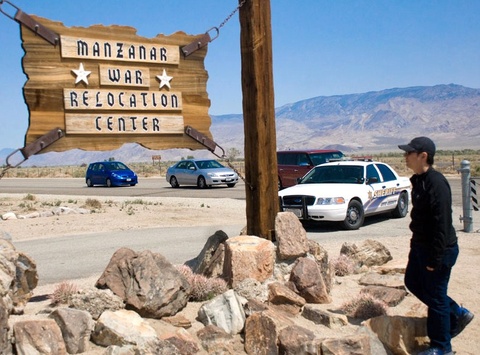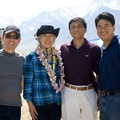Please understand…I didn’t want to go to see Manzanar. I NEEDED to go there.
Over the years, whenever I had vacation days available, I would always think of visiting Manzanar, one of the ten concentration camps in the U.S. where nearly 120,000 people, mostly Americans of Japanese descent were racially profiled and imprisoned in 1942, but somehow, it just didn’t seem like a nice getaway from the stresses of everyday Chicago living. I’m pretty certain most descendants of ex-internees feel the same way. Understandable. On a personal level, Manzanar is where my mother Ruth was incarcerated at age 14. This however, is not a story about Executive Order 9066—the presidential order that resulted in the mass imprisonment of Americans based solely on race. There are volumes of excellent materials available on the subject. This rambling narrative is the culmination of a son trying to unravel the mystery of a few, yet pivotal dark years in his mother’s life.
We, the third Generation Japanese Americans (Sansei) are slowly becoming the “new elders.” Careers. Marriage. Kids. Life rolls on relentlessly. Next thing I knew, Mom and Dad had passed away. Suddenly I had become the pilot of the family’s legacy in a post 9/11 world. Of course we would tell our kids about their Grandma “Bachan” being in the concentration camps and dutifully take them to all of the Japanese American community events around Chicago. But somehow—as much as I had read about it, I couldn’t connect with what these “camps” were like.
How can one imagine: High School dances, machine gun towers, Japanese gardens and child prisoners—all in one place? The only way to explain the feeling is: it’s like finishing a puzzle, only to find there’s a piece missing. We feel unsatisfied, then anger, then shrug and throw it away. I was ok with it. Kind of. Not really.
Then one day I painted myself into a corner. Big time. As I was emceeing the Chicago 2012 Day of Remembrance (The Chicago Japanese American Historical Society/J.A.C.L. co-sponsored D.O.R. commemorates the signing of 9066), I was pontificating about how important it was to recapture our ancestors’ experiences. Yes, I was being “that emcee guy” saying: “blah blah blah, Zzzzzz…” and randomly I blurted out that this is the year I was going to visit Manzanar. As soon as I said it, my mind screamed “retract”…thell them you “MIGHT” go there! After all, it’s not a snazzy, convenient tour stop with a Starbucks and pool. 230 miles from L.A. 260 miles from Las Vegas. The desert? No regular “cushy” tour buses even go there! But if there’s anything I have inherited from the hard headed Issei, it’s the fact that “if you say it in front of everybody, you gotta do it or lose face”
At the D.O.R., Bill Yoshino announced that the Chicago JACL is offering a wonderful program called “the Kansha Project” which will take a group of students out to the Manzanar site for research and a sleepover. GREAT! Oh wait…Dang, I’m too freakin’ old to apply—but I’m happy to report that my two college age kids are interested. And of their own free will…without Asian-parental-guilt! (Bonus!)
As you know, timing is everything in life. I remember hearing about this Annual Manzanar Pilgrimage that was started in 1969 by an amazing group of activists, which has now evolved into a major annual event. After much hesitation, I called their office in L.A. and Bruce Embrey, son of the late, great Pilgrimage pioneer Sue Kunitomi Embrey answers. With grace and kindness, he fields my questions, and we discover so much common ground. Bruce lived in Chicago for many years and we “talk story” a bit. He then mentions one thing that stuns me. The Pilgrimage bus that leaves L.A. will depart from the old Maryknoll School (now St. Francis Xavier), exactly where my mother boarded in 1942. It’s hard to describe what that connection did to my soul. I had an instant memory of my mother’s voice describing how they crammed onto buses and tried to peek through the covered windows. You see, I had never found a way to actually connect with my mother’s experiences. It was all hearsay and theory. I’m sold instantly. In my own way, using the vague sketches from her stories, I could parallel her journey 70 years later. Suddenly, I NEEDED to go. In 2001, as an angrier, younger man, I wrote and produced this song on my “State of Mind” CD called “Liar”:
“Take what you can carry”—the soldier said to me
“Sammy” and his friends have sent us
Gather up your family
You’re going on vacation, not so far away
There’s a special place that we’ve prepared
Where you can frolic night and day”
Liar, talkin’ to me with that gun in your hand
Liar, don’t you know that I was born in this land?
“We’re caught up in a panic, there really is no choice
You can kick and scream about it
But our machines will drown your voice
Something bad is starting in the friendly skies
It’s raining smoke and fire in our paradise
Madness sweeping all across the sacred land
That’s why the nation needs a sacrificial lamb…”
Liar, let me go ‘cause I see hate in your eyes
Liar, let me go. Evil knows no disguise*
As I search airfare and hotels online, an email pops up from Darrell Kunitomi (L.A. Times, Pilgrimage emcee and nephew of Sue Kunitomi Embrey) inviting me to help them lead a unity sing-along during the ceremony. Deeply honored by this request, I know for certain that this is the right time to make the journey. Within minutes, my arrangements are booked.
In 1941 my mother Ruth Yoshida’s family lived comfortably on Santa Monica Boulevard near the pier. Perhaps I can stay near there. Somewhere in a big pile of papers is that address. Unfortunately I inherited the Nisei’s tendency for hoarding, which was exacerbated by living in poverty while incarcerated. Funny thing about hoarding—when you need the stuff you saved, sure as hell you won’t find it! I settle for a room in L.A’s Little Tokyo.
*Excerpt from LIAR ©2001 Keith Uchima, Delectable Music (available on iTunes)
*This article was originally published on the Chicago Japanese American Historical Society website on May 27, 2012.
©2012 Keith Uchima







